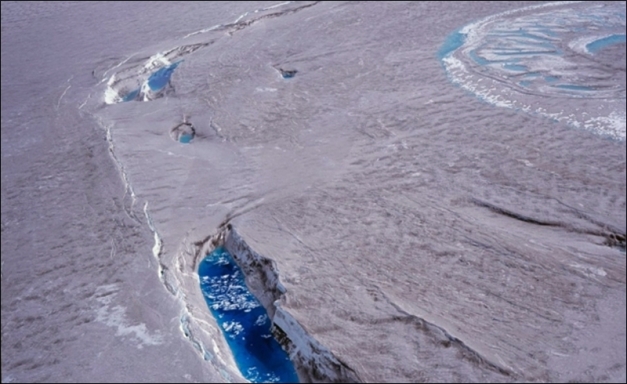
The Eastern Skaftárketill caldera seen from the air, at the beginning of the 2010 outburst flood. Photo/IMO
Every two years on average a jökulhlaup happens under Vatnajökull in Iceland. As the last one was in June 2010, the present flooding is expected to be much stronger than usual. These floods happen because glacier ice is melted by hydrothermal heating and the water collects in lakes under the ice. Once a “pot” is full, it starts flowing over, down the slopes, first below ice and then over the coastal sander planes towards the sea. The floods can get very powerful, taking down bridges and submerging the coastal roads. On the glacier’s surface, the ice sinks as the water empties out, forming a cauldron, the increasing depth of which is measured by GPS to estimate the progress and volume of the flooding.
The Icelandic Civil Protection Agency has also warned travellers and mountaineers to stay away from where the river emerges from beneath Tungnaárjökull, Skaftárjökull or Síðujökull glaciers and the rivers Skaftá and Hverfisfljót. (Src: Iceland Magazine). Update 15.50 LT: The sulphurous smells have now been reported from unusually far away places: http://www.ruv.is/frett/hveralykt-berst-yfir-austurland
Warning displayed on the IMO pages: Note: Along with running water is expected a release of volcanic gases such as hydrogen sulfide and sulfur dioxide. The gas follows the prevailing winds and is carried to the northeast from Skaftá to the Eastern country.
Latest Expert’s Statements on IMO’s Hydrology page (http://www.vedur.is/#syn=vatnafar):
(Transl. by Google!)
Expert on duty, 01 Oct. 15:17: Skaftárhlaup was stated on the meter Sveinstindur at 03:30 last night, Oct. 1. Flow increase at Sveinstindur shows the fastest rate since the station was established in 1971. The first studies indicate that the flow will be one of the largest from the Skaftárkötlum. The flow was a little less than 1300 m ^ 3 / s Sveinstindur at 15:00 and still growing rapidly. At 10:00 the water reached the meter of the town Skaftárdalur and the flow measured almost 400 m^3/s at 15:00 hours. Below the Laki Valley the Skaftá river is divided into three courses – one out of Eldvatn with legs through Flögulón down Kúðafljót, one out of Eldhraun in Árkvíslum and the third runs past Kirkjubaejarklaustur. Yet is the GPS of the eastern Skaftá and shows it has sunk more than 66 meters. Last 1-2 hours has slowed down significantly, suggesting that the maximum flow out of the cauldron is reached.
Expert on duty, Sept. 30, 2015, 15:25: Eastern Skaftá Kettle continues to fall with increasing speed. This indicates that the boiler flow increased rapidly now. The subsidence of the pot is now more than 11 m which is only about 10% of total level to be looked at. Running water runs still under western Vatnajökull probably towards the channel Skaftá which is expected to have the first signs of flooding shown on Thursday morning (October 1). It takes running water for 4 hours to reach the first water meter station Sveinstindur. We expect the flow of water out of the stream to lower the Laki late on Thursday and the effects of the gel could be next week.
Aerial views over the Skaftá River sanders by Víðir Reynisson from yesterday, 29 Sept:
http://tinyurl.com/LinkedByGranyia
Live GPS, updated every 5 minutes and averaged every half hour, of the cauldron surface: http://www.vedur.is/um-vi/frettir/nr/3202
Watch it live!
You can follow the dramatic changes occurring in the Skaftá river due to the glacier river flood currently under way here. On your first visit you may have to log in. If so, the user name (‘notandi’) and password (‘lykilorð’) are available on the right-hand side of the log-in page. Once in, click on ‘Suðurland’ on the left-hand-side menu, then on ‘Skaftá við Sveinstind’. (Src.: http://icelandmonitor.mbl.is/news/nature_and_travel/2015/10/01/skafta_flood_this_could_be_very_big/) EDIT: I tried this and it did not work for me. Far better to access the data here: http://vmkerfi.vedur.is/vatn/vdv_gmap.php
Bernard Duyck has a wonderful photo of the cauldron in his post (blog Earth of Fire, see permanent link in the sidebar)
Good article on earlier jökullhlaups, with lots of photos (but the Google translation is horrible):
http://www.mbl.is/frettir/innlent/2015/09/30/urdu_innlyksa_vegna_hlaupsins/
Can the volume and extent of jökulhlaups be predetermined to alert the public in advance?
Flood Monitoring Meters
The massive floods in December 2006 came as a surprise. One of the most affected were the White River basin in Árnessýslu, Borgarfjörður, Héraðsvötn Skagafjordur and Skjálfandafljót. Hydrological NEA, now the IMO, were gauging all these catchment areas. Only one of them, Skjalfandafljot the Aldeyjarfoss was prepared to send alerts for flooding, for the measurements to monitor potential volcanically induced floods of the northern parts of the glacier. Following the floods, the agency tasked with monitoring changing water levels suggested high water areas in Árnessýslu, Nordura in Borgarfirði and Héraðsvötn Peninsula in bays so that the meters would send an alarm if the water level exceeds a certain limit. This will be a warning for potential flooding, of course with some reservations. It was also decided to install new water level gauges in the flood zone, both to monitor flooding and give warnings. For this purpose were installed three new meters in the flood areas of the White River in Árnessýslu and Ölfusá, one meter in flood zone Nordurardalur and Borgarfirði, one recommends Eyjafjarðará, one of the flooded areas in Skjálfandafljót. Water meters have been working for long in the flood zone Héraðsvötn and been used to monitor flooding in Skagafjörður. Data from these gauging and others are available in IMO’s gauging system.
Following the floods in December 2006, the Icelandic government entrusted the Hydrological Service to map possible flood limits of the main flood zone. It became necessary first to build up a database of floods as a basis for calculations and decisions. Historical flood marks were traced, the pins were set up in key locations and their height measured in with a precise GPS device. This information was posted on detailed picture maps with the help of land information systems, but also photos taken at the floods, as well as information from landowners, were integrated in the mapping.

Internationally, new software for modelling possible floods has been developed. This is what a model looks like – this one was created for another flood prone area in Iceland
The IMO has been working on a project on risk assessment and risk management of river floods. Part of the project relates to the attitude of the population to flooding and land use planning in flood areas. The project is a collaboration of the University of Iceland and the Icelandic Meteorological Office. Analysis of flooding is done in geographic information systems and preliminary results indicate that it is not possible to use the flow data to determine the size of flooding.
I understand that it will rather be necessary to watch actual water levels than just the amount of water flowing as the underlying morphology (river gorges vs. plains) and the type of ground would play an important role as to how much water can be accomodated in a given area. With time, such models wil be developed that involve ground permeability, possible amounts of erosion and sedimentation, gradients, and even the weather at expected flooding times.
Enjoy! – GRANYIA
UPDATES
1 Oct. 2015, 
15:00 GMT: Now the measurements are indicating the most likely ways of the water flows, see map left. – IMO states that, from initial observations, the ongoing jökulhlaup could be the largest to have occurred from the Skaftárkatlar cauldrons. – Heavy rains today and more forecast for the coming days will add to the floods.
17:50 GMT: Surface depth of the cauldron is 68,3 m, possibliby stagnating, which could mean that the peak outflow has been reached…
18:15 GMT: now 67.1 m, so the flow rate will possibly decrease from now on. For the areas further down the worst is still to come, though.
2 Oct. 2015
Today, the general consensus in the media is that this jökulhlaup will be one of the biggest, if not the biggest in recorded history, judging from the fast rise and the massive flow rate of up to 3000 m³/s. Of course this remains to be calculated after it has ended. The floods are muddy torrents carrying large amounts of debris, tearing off big chunks of the river banks. The bridge over Eldvatn, and also the eastern part of road 208, are now closed. Hydrologists wanting to take water samples at a station could not reach the place.
– IMO: The flow at Skaftá, Sveinstindur gauge, peaked at approx. 02:00, 2 October. According to gauging the flow amounted to just under 2100 m³/s at the peak. We can expect that the real flow, however, could have varied considerably as much water flows outside the measuring range of the station. May even assume that the flow has been about 3,000 m³/s. – The flow at the Eldvatn of Asa gauge was still rising in the morning and at 11:00 was about 2150 m³/s. It peaked at 13:00 today, 2 Oct., and was 2,200 m³/s. Much water is also running in the area outside the main water channel which will be flooded for the coming days.
– IMO: A series of photos taken yesterday from a farm at Búland, which was one of the first places up river to be affected by the flood: http://www.vedur.is/vatnafar/frodleikur/greinar/nr/3208
– Daily RUV (TV) news can be watched online here: http://www.ruv.is/nyjast/frettir
– Three webcams of the Road Department can be accessed here: http://vegasja.vegagerdin.is/?xmin=378961&ymax=435900&xmax=553861&ymin=311640
mbl.is: The Skaftá glacier river flood is now making itself well felt in areas of South Iceland. The gushing waters are causing severe damage to farmland, breaking through protective walls, and flooding entire fields. Locals have described the flow of the river as “unprecedented” and a “great natural disaster”.
Grapevine.is:
Flood waters from the Eystri Skaftárketill caldera have begun to subside, and south Iceland’s bridges and roads have been spared considerable damage. RÚV reports that the bridges over Eldvatn and Kúðafljót have withstood the flood waters that began earlier this week, and appear to be subsiding. The Road and Coastal Administration is now trying to direct waters away from Route 1 between Eldvatn and Kirkjubæjarklaustur. (more)
Click on Gallery to open large views:

3. Oct. 2015
Authorities urge anyone who is in the area of caution, particularly because of toxic hydrogen sulphide that can accumulate in high concentrations, among other gasses along Skaftá banks. – Volcanic gasses, particularly notable H2S, are carried to northern Europe: During half an hour ten residents in Trondheim, Norway, contacted the police reporting a stink of rotten eggs.
– IMO: GPS station has stopped transmitting about 13:00 on 02 Oct., however the depth in the graph is given as 82,7m, much lower than the red line is showing… – The flow in Skaftá Sveinstindur is 1160 m^3/s compared to the 3,000 m^3/s at the peak.
– lhg.is: The floods are declining everywhere now but there is still a lot of water around. With scientists and representatives of the Civil Protection Department and the Police on board, a helicopter of the Coast Guard, TF-SYN, flew this morning to the flooded area near the Skaftá river. Three bridges near Skaftárdalur village were affected, the road was interrupted in four places. The electricity line of Skaftá seemed in good condition. On its way back from the research flight the helicopter received a request to save three tourists whose car got stuck near Hólaskjól.
– islandsbloggen.com: Unexpected large amounts of water have flowed into the lava field Eldhraun. On a kilometer stretch along the ring road, the water has risen so high that the distance up the road is only three inches. The Jökulhlaup is not over yet. The ice cover over Skaftárjökull’s eastern caldera has so far fallen about 74 meters and continues to drop, which means that more meltwater is still flowing from the glacier into the Skaftá river, although the flow rate has slowed down considerably. (more)
Dramatic mbl Video of an overflight (it begins with an Ad and, for me, it is very slow loading):
http://www.mbl.is/frettir/sjonvarp/166789/
Images that appeared on the web today (may have been taken earlier). Click on Gallery to open larger views:









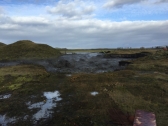




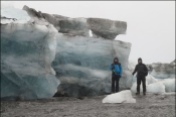

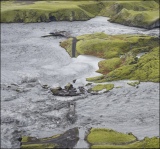

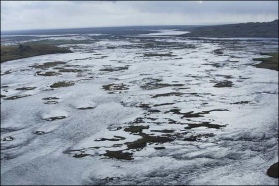


Outburst floods are accompanied by poisonous gasses rich in sulphuric acid
Far be it from me to query a more or less official report, but sulphuric acid? As a gas? Hydrogen sulphide, yes, sulphur dioxide, yes; but I beg leave to doubt H2SO4 as a gas. For starters, sulphuric acid is so hydrophilic that it would essentially all have dissolved into the water tout le suite. What do the experts on here think?
LikeLike
Hi Michael, by no means am I an expert, but sure you are right, and we might have a mishap of translation issue here. However, if I remember right from my chemistry training, sulphuric acid can be formed when sulphuric gases react with air humidity (water), and subsequently be carried in very diluted form via air. Then we have steam/vapour containing H2SO4, and/or acid rain. This has been the very obvious case when, in May/June 2011 (Grimsvötn) in all the northern half of Ireland (and to a lesser extent further south up to Germany) leaves of trees got burnt dark brown, worse than ever seen in autumn.
In the post I had cited the first issue of that warning, which was specified later yesterday to “[gases] such as hydrogen sulfide and sulfur dioxide”. I’m going to change it now, thanks for the tip!
Question: is the “f” in sulfur becoming common use in English? I would be far happier with that than with “sulphur” 🙂
LikeLike
Hi Granyia; yes, you’re probably right about it being a translation mix-up. I know there ARE cases where an aerosol of sulfuric acid has caused serious burns, but these have tended to be where an eruption has suddenly expelled a strongly acidic crater lake (Taal in 1911 maybe one such). But in this case the acid gases will be in intimate contact (oo-er missus!) with a LOT of water for a fair length of time. You will still get H2S and possibly SO2, but the acid itself will show up only as a decrease in pH of the outflow.. On your other point: I was brought up to use ‘sulphur’ but on reflection I think now that its maybe better to use the American spelling, for a consistent usage on this blog.
LikeLike
“but the acid itself will show up only as a decrease in pH of the outflow”… and what is a decrease in ph? A high content of (e.g. sulfuric) acid which is formed easily and fast in water, if pure S or SO2 is present (I don’t know about H2S, it is always SO2 mentioned in this context).
Wikipedia has to say on acid rain:
“The principal natural phenomena that contribute acid-producing gases to the atmosphere are emissions from volcanoes. Thus, for example, fumaroles from the Laguna Caliente crater of Poás Volcano create extremely high amounts of acid rain and fog, with acidity as high as a pH of 2, clearing an area of any vegetation and frequently causing irritation to the eyes and lungs of inhabitants in nearby settlements.” and “When clouds are present, the loss rate of SO2 is faster than can be explained by gas phase chemistry alone. This is due to reactions in the liquid water droplets. […] There are a large number of aqueous reactions that oxidize sulfur from S(IV) to S(VI), leading to the formation of sulfuric acid. The most important oxidation reactions are with ozone, hydrogen peroxide and oxygen (reactions with oxygen are catalyzed by iron and manganese in the cloud droplets)”
In our Skafta case, the (more or less) acidic lake had existed 5 years under the ice, probably influenced by volcanic gases supplying S all the time. Thinking about it, I do believe that the water vapours carry (and with the present SO2 still produce as they flow out) sulfuric acid indeed.
I am looking at my photos of the plant damage again, and I still find it amazing that up to this day apparently nobody thought it worth mentioning the fact that a volcanic eruption in Iceland damaged the greenery (trees, garden plants, herbs et al) of an entire region involving at least three countries (where I have witnessed it myself) for the whole season. Well, many of the plants grew new leaves all over, but not so the trees in that year. The locals told me: oh that… that’s only wind-burn, happens very rarely, last time 20 years ago, when all the daffodils were burned by a cold storm… Of course I couldn’t tell them, look up the GVP, it was Hekla’s work in 1991! It is a s clear as vitriolic oil to me that it was the acid in the air moisture that had been blown south by that violent storm on 28th or 29th of May 2011 (which originated from a very low low over Iceland). Or, the Sulfur itself could have been carried over with the ash that came aplenty, and, clinging to all surfaces, sulfuric acid had been formed with the moisture on the spot.
Some may remember that I have posted comments on the burned plants in several other blogs and forums since 2011, but as there has never been an answer I am still waiting for someone who can confirm or dismiss my reasoning. — Oh, it got a bit long, sorry…
LikeLike
Howdy all –
Interesting article in PhysOrg about island flank collapse at Fogo. Cheers –
http://phys.org/news/2015-10-ancient-megatsunami-portend-modern-hazard.html
LikeLike
And another PhysOrg article that rolled off. Recovered from Science Daily. The closer they look at the K-T event, the closer in time the impact at Chicxulub and the prolific portion of the Deccan Traps appears to be. This article claims around a 50,000 year delta, which is really close based on how far in the past it was. Cheers –
http://www.sciencedaily.com/releases/2015/10/151001153038.htm
LikeLike
Post updated, also added gallery with today’s images.
LikeLike
WOW! Click on the pic to enlarge and find the tiny red-and-white hydrologist’s shelter hut in front of the bridge!
Skaftárhlaup 2 October 2015. One of the many bridges in Skaftárdalur is ‘umflotin’.
More photos of this flyby today here: http://www.vedur.is/um-vi/frettir/nr/3212
LikeLike
I’d not want to be a hydrologist in that hut! I mean, there’s getting close to your work, but that would be maybe beyond the call of duty 🙂
LikeLike
Oh, you’d need the hut only in boring dry weather, these days the water to be analysed is visiting you at home, coming to your doorstep by itself… Am I allowed to lol or is the matter too serious now?
LikeLike
Is anyone from Iceland here (hello Islander??) and could help us? I have noticed that the daily “comments by an expert” on the IMO website differ considerably comparing the English versus Icelandic version.
Today’s Icelandic is:
“Vatn lekur að jafnaði úr Skaftá út á Skaftáreldahraun. Hraunið virkar sem sía á jökulgorminn í vatninu. Vatnið kemur fram sem hreint lindavatn undan hraunjaðrinum. Eftir 230 ára síuhlutverk er hraunið orðið fyllt að stórum hluta og yfirborðið farið að þéttast. Allar líkur eru á að næstu daga muni jökulvatn ná fram af brún hraunsins út á Landbrotshraunið sem er undir Eldhrauninu og renna eftir farvegum lindalækjanna. Jökulvatnið mun fyrst koma fram í Tungulæk. Skrifað af vakthafandi sérfræðingi 03. okt. 13:51”
Could we get a translation, pretty please?
Today’s English version is different from yesterday’s as well as different from the Icelandic, telling us mostly what everybody knew already:
The Skaftá outburst flood peaked downstream at midday on 2 October. On the Eldvatn river, discharge peaked at ~2,200 m3/s, excluding floodwater that overtopped a levee upstream from the bridge over Eldvatn. Note that floodwater will continue to drain in the coming days through the Eldhraun lava-field, resulting in water accumulating against Highway 1 between Eldvatn and the western outskirts of Kirkjubæjarklaustur. For travel information, see: http://www.safetravel.is and http://www.road.is. Written by a specialist at 03 Oct 13:51 GMT”
http://www.vedur.is/#syn=vatnafar (I)
http://en.vedur.is/#tab=vatnafar (E)
LikeLike
Updates added to the post, probably the last one if nothing exciting happens during the coming days.
LikeLike
This is really good, Granyia. Nicely done, Madam. Cheers –
LikeLike
Almost six weeks into the eruption, Piton de la Fournaise is still going strong and steady:

Just for the record:
An earthquake swarm on the Conchagua Peninsula (SE El Salvador), covering the area of inactive Conchagua volcano, has produced 1081 shallow EQs up to M 4.5 since Sept. 29. 2015. In their report. MARN state that the seismicity is caused by the activation of local faults. A similar swarm in 1991 had over 7000 EQs, another in 2011 almost 2000. http://www.marn.gob.sv/index.php?option=com_content&view=article&id=3475%avisos-ciudadano&catid=25%3Athe-cms&Itemid=76
Cotopaxi
showed an episode of continuous tremor again for several hours this afternoon:
A while ago a photographer had been publicly accused of publishing manipulated pictures showing incandescence in Cotopaxi – wrongly, as it seems now! I feel sorry for the man, because surely his reputation got stained by this. Yesterday (3 Oct.) the IGEPN’s own webcams registered a quite impressive glow from the crater.
Now Cotopaxi does what everybody expected but nobody wanted to happen – it entered a new phase of activity, whith magma rising quietly inside. Temperature measurements and visual surveillance show that the glacier on its upper part is melting rapidly, cracks appear in the ice and blocks of ice are falling down the steeps slopes. This melting has already caused small lahars in recent weeks as the melt water trickles down and remobilizes ash laid down earlier by the phreatic eruptions. This was detected during an official overflight on 27 Sept. (Src.: ElComercio.com, 03/10/2015)
LikeLike
Veniaminof (Alaska) has been set on Yellow (Advisory) alert
“Beginning Wednesday, September 30, seismic activity in the form of small low-frequency earthquakes began to be detected at Veniaminof. On Thursday, AVO raised the Color Code/Alert Level to Yellow/Advisory. The character of the seismicity is similar to that seen previously at the volcano, most recently in the waning stages of the 2013 effusive eruption. Most satellite and webcam views from the past few days have been obscured by clouds. Clear views yesterday morning from the FAA Perryvile NW webcam showed no eruptive activity at the volcano.” Src.: AVO Weekly http://www.avo.alaska.edu/activity/Veniaminof.php
All further daily reports say tremor is continuing but there is no no evidence of an eruption.
Interesting looking volcano!

August 18, 2013: A small puff of ash emerges from the active cone inside Veniaminof caldera. A beautiful fan of lava flows active earlier in the summer descends the south flank of the cone onto glacial ice producing white steam clouds and depressions where melting has occurred. The surrounding glacier is darkened by recent ash fall. (Image: AVO/McGimsey)
LikeLike
Sounds like I need to look into that one. Need to figure out if it was done earlier. Cheers
LikeLike
Wow, here is something interesting!:
“The first simulation of the individual crystals in volcanic mush, a mix of liquid magma and solid crystals, shows mixing to help understand pressure buildup deep inside a volcano.” Even I can understand that video… 😉 Ref: G. W. Bergantz, J. M. Schleicher & A. Burgisser. Open-system dynamics and mixing in magma mushes. DOI:10.1038/ngeo2534 Read more : http://www.geologypage.com/2015/10/simulating-path-of-magma-mush-inside.html
LikeLike
The simulation demonstrates why only a relatively small part of the eruptible magma in a crystal mush actually erupts. Wonder how close it is to reality. Cheers –
LikeLike
Popocatepetl is in a more excited mood than usual tonight:

and CENAPRED have zoomed in on the Tlamacas webcam. Here an animation:

http://volcams.malinpebbles.com/pubweb/C-Amerika.htm#MX
LikeLike
And a great image of it via Twitter by @9chuitorres
LikeLike
ALAID, northern Kurile Islands: Aviation Color Code set to YELLOW. KVERT reported that an intense thermal anomaly was detected in satellite images over Alaid starting at 03h05 on 2 Oct., possibly due to Strombolian activity. Up to date moderate eruptive activity of the volcano probably continues. Satellite data still showed a thermal anomaly over the volcano. Three images below are from
1. Landsat 8 OLI, 05/10/2015 – 2. TERRA/MODIS 07/10/2015 – 3. MODVOLC 05-07/10/2015 (three days combined)
Alaid is a stratovolcano “Somma-Vesuvius”-type, on the Island of Atlasova, ca 70 km SW of Kamchatka. Inside the summit crater is a young cinder cone of 250 m hight. On the slopes of the volcano 33 side cinder cones have been produced by earlier eruptions. It breeds basalt (sorry, Google joke, couldn’t refrain! should read: erupts basaltic lavas), and its ashy eruptions can affect the neighboring inhabited islands and most often international aviation routes crossing the area.
Fumarolic activity of volcano Alaid Oct. 27, 2012, by N.V. Ushakov, via KVERT
LikeLike
New post is up! 🙂
LikeLike
Pingback: De puerto en puerto : Un día en Fjallabaksleið Nyrðri